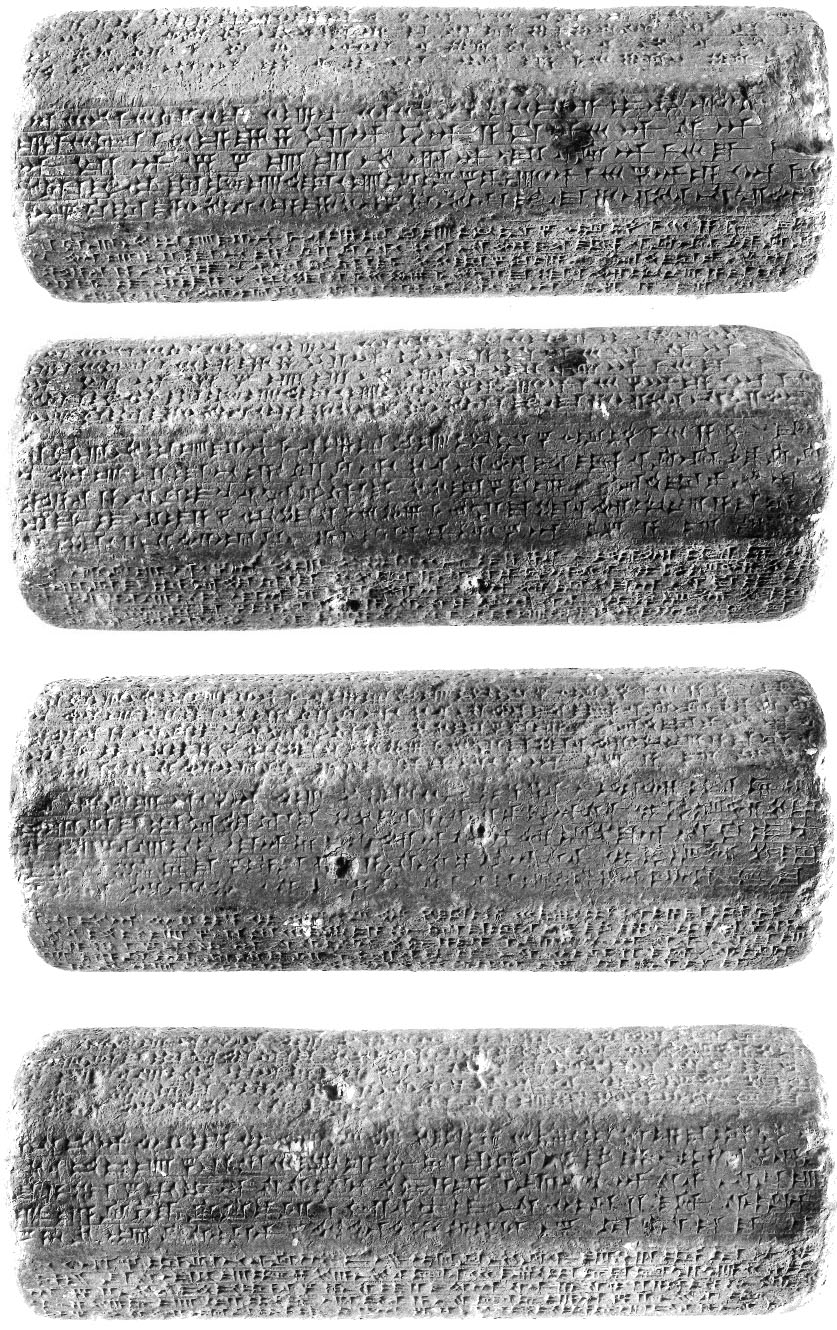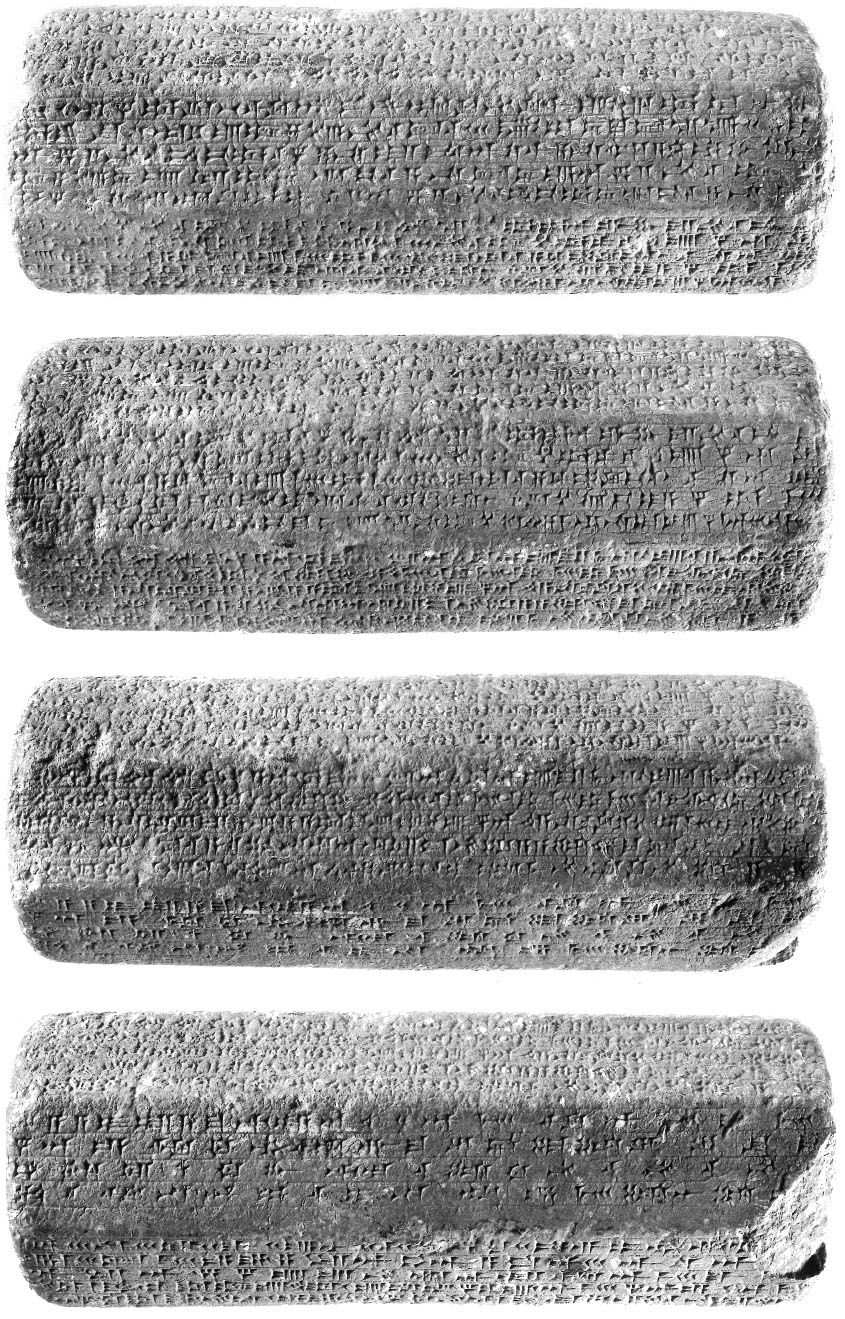- Home
- Explore RINAP Home Page
- Browse Online Corpus
- Access RINAP 3 Scores
- Access RINAP 3 Sources
- RINAP 3/1 Front Matter
- RINAP 3/1 Introduction
- RINAP 3/1 Text Introductions
- RINAP 3/1 Back Matter
- RINAP 3/2 Front Matter
- RINAP 3/2 Introduction
- RINAP 3/2 Text Introductions
- RINAP 3/2 Back Matter
- Oracc Lemmatization Colors
- Citing RINAP URLs
- Reusing RINAP material
- RINAP Downloads
Aššur, Part 1
164 [/rinap/rinap3/Q003969/]
VA 5634, an octagonal clay prism from Aššur, is inscribed with a text describing eight of Sennacherib's military campaigns and the renovation of the Old Palace at Aššur. Although the prism is complete, its entire surface is very worn, making it impossible to read most of text inscribed upon it. The fifteen-line building report is sufficiently legible, however, to allow us to determine that that passage records the renovation of the innermost part of one of Aššur's palaces, a royal residence worked on by Tiglath-pileser I (1114–1076) and Ashurnasirpal II (883–859); Sennacherib states that he regarded those kings' work as being poorly done. After the construction came to a close, the god Aššur and the other gods of the city were invited inside for a festive celebration. Only the building report is edited here. Although the prism is not dated, its date of composition is ca. 691–689 — around the same time as text nos. 18 and 22–23 — since its terminus post quem is the battle of Ḫalulê (described in cols. vii–viii), which occurred during the king's eighth campaign (691).
Access Sennacherib 164 [/rinap/rinap3/Q003969/]
Source:
Commentary
Despite the poor condition of the prism's surface, the text is sufficiently preserved to be relatively certain that the military narration duplicates, with orthographic variants, text no. 22 i 1–vi 35 and text no. 23 i 1–vi 30, that is, accounts of eight campaigns: (1) against Marduk-apla-iddina II (biblical Merodach-baladan) and his Chaldean and Elamite allies in Babylonia; (2) against the Kassites and Yasubigallians, and the land Ellipi; (3) to the Levant, against an Egyptian-led coalition that had been organized by the nobles and citizens of the city Ekron, and against the Judean king Hezekiah; (4) against Bīt-Yakīn; (5) to Mount Nipur and against Maniye, the king of the city Ukku; (6) against the Chaldeans living in Elam and against Šūzubu (Nergal-ušēzib), the king of Babylon; (7) against Elam; and (8) the battle of Ḫalulê, where Assyrian forces battled Babylonian and Elamite forces led by Šūzubu (Mušēzib-Marduk), the king of Babylon, and Umman-menanu (Ḫumban-menanu), the king of Elam. Accounts of the events of the king's 9th and 10th regnal years (696 and 695), the campaigns undertaken by his officials to Ḫilakku (Cilicia) and the city Tīl-Garimme, however, are not included among the king's victories on the battlefield. The line preceding the building report reads ⸢šá⸣ a-na ⸢nap⸣-šá-te ⸢ú-ṣu-ú i-kaš-[šá]-⸢du ú⸣-ra-sa-bu ina ⸢GIŠ⸣.[TUKUL] "they c[au]ght (the runaways among them) who had fled for (their) lives (and) killed (them) with the [sword]" the last line of the eighth campaign (see, for example, text no. 22 v 17–vi 35), and, therefore, it is assumed that the military narration of this text duplicates that of text nos. 22–23.
Since the introduction and military narration are poorly preserved and since these sections duplicate well-known texts, these parts of the inscription are not edited here. Only the building report, approximately the last quarter of col. viii, is included here. Note that the line count follows that of the building account, and not the line count of col. viii of the prism since it is no longer possible to accurately assign line numbers to the entire column due to the poor state preservation of that column's surface; see also Frahm, KAL 3 pp. 84–86 no. 40.
Bibliography
165 [/rinap/rinap3/Q003970/]
Several fragments of an octagonal clay prism from Aššur are inscribed with a text describing Sennacherib's military campaigns and building activities at Aššur. Parts of the reports of the king's first three campaigns and the final lines of the building report are preserved. The building report, which is not duplicated elsewhere in the known Sennacherib corpus, describes construction at Assyria's principal cult center, but, because it is poorly preserved and difficult to read, its contents are uncertain. It appears, however, to mention the walls and gates of the city Aššur. Like text no. 164, the prism does not have a date written on it. Because the military narration is not preserved beyond the third campaign (to the Levant), a precise terminus post quem cannot be established.
Access Sennacherib 165 [/rinap/rinap3/Q003970/]
Source:
Commentary
Parts of the tops of the first three columns (cols. i–iii) and the lower part of the last column (col. viii) are preserved. Most of the surface of this prism is very badly worn, just like the prism inscribed with text no. 164. The edition here does not include A 61 (Istanbul) since that piece was not available for study, neither from the original nor the excavation photo (Ass ph S 4955); the tentative, non-physical join between that fragment and VA 5061 + VA 5632a + VA 5632b + VA 7512 was suggested by E. Frahm (KAL 3 p. 33). Although the building report is badly damaged and difficult to read, it is certain that it is not duplicated elsewhere in the known Sennacherib corpus. Frahm notes that it mentions the walls and gates of the city Aššur. Unfortunately, the authors were unable to properly re-examine this passage, giving it the full treatment it deserves. Further collation could clarify the interpretation of this badly damaged, but unique, building report. As for the military narration, the extant passages duplicate, for example, text no. 16 i 34–70, ii 10–62, and iii 20–64. Restorations are based on that text.
Bibliography
166 [/rinap/rinap3/Q003971/]
Two eight-sided horizontal stone prisms found at Aššur — one complete and one only partially preserved — are inscribed with a text recording Sennacherib's work on Ešarra, the Aššur temple in that city, in particular his work on its cella Eḫursaggalkurkurra, its šuḫūru-house, and its new courtyard and gates. This text is unusual for two reasons: (1) horizontal stone prisms with Assyrian royal inscriptions are not common, and (2) the text says nothing about the king's military achievements, other than some general phrases among the epithets. The date of composition is generally thought to have been after the capture and destruction of Babylon in late 689. The text is sometimes referred to as the "Aššur Temple Inscription."
Access the composite text [/rinap/rinap3/Q003971/] or the score [/rinap/scores/Q003971/score] of Sennacherib 166
Sources [/rinap/scores/Q003971/sources]:
Commentary
These stone prisms are a blend of the prism and cylinder formats: Each line of text is written along the wide horizontal axis of the object and each of the eight horizontal columns is inscribed with five lines. In many regards the object type has more in common with (barrel) cylinders than with prisms. Ex. 2 is fragmentarily preserved and the three fragments comprising that exemplar are known from Aššur excavation photographs, but with each piece photographed individually. L. Kinscherf copied Ass 17399 in his unpublished dissertation, O. Schroeder noted the (orthographic and paleographic) variants in Ass 18334 in his notes to the copy of Ass 18434 (ex. 1) in KAH 2 (no. 124), and Ass 18617 remains unpublished. The pieces are reported by O. Pedersén to be in the Vorderasiatisches Museum (Berlin), but they could not be found (May 2011). Therefore, Ass 17399 + Ass 18334 (+)? Ass 18617 were collated from the Aššur excavation photographs Ass ph 5179, S 6812, and S 6854. Following previous editions and studies, the inscription is given consecutive line numbers for all eight faces. Face i = lines 1–5, face ii = lines 6–10, face iii = lines 11–15, face iv = lines 16–20, face v = lines 21–25, face vi = lines 26–30, face vii = lines 31–35, and face viii = lines 36–39. The master text is ex. 1. A score is presented on the CD-ROM. Since the full text of ex. 2 is not known, ellipses (...) appear in the score for the portions of that exemplar where the authors could not verify its contents. Moreover, the one known variant is listed at the back of the book.

Faces 1–4 of VA 8254 (text no. 166 ex. 1), a horizontal stone prism inscribed with a text describing the construction of a new multi-room complex to the Aššur temple at Aššur.

Faces 5–8 of VA 8254 (text no. 166 ex. 1), a horizontal stone prism inscribed with a text describing the construction of a new multi-room complex to the Aššur temple at Aššur.
Bibliography
167 [/rinap/rinap3/Q003972/]
A fragment from the upper portion of a stele found at Aššur preserves the beginning of an inscription of Sennacherib that records the construction of the akītu-house (New Year's temple) at Aššur. The text is very similar to the beginning of text no. 168 and no doubt dates, as that text does, to the post-689 period (possibly ca. 683, around the same time as the next text). The inscription is accompanied by a scene showing three human figures, two of which are standing on the backs of animals.
Access Sennacherib 167 [/rinap/rinap3/Q003972/]
Source:
Commentary
What is preserved of the inscription is similar to text no. 168, a text inscribed on a stone tablet discovered at Aššur. The prologue (the king's name and epithets) is shorter in text no. 167, but the building reports are identical. Cf. text no. 168 lines 1–30. The restorations are based on that text. For some speculation on where the stele was originally erected — in the Aššur temple or in the akītu-house — see Frahm, Sanherib p. 174.
Bibliography
168 [/rinap/rinap3/Q003973/]
VA 8248, a large stone tablet from Aššur, is inscribed with a text describing Sennacherib's construction of the akītu-house at Aššur; we are told that the temple had been forgotten for a very long time and had fallen into decay. Of particular note is that people from Dilmun helped destroy Babylon; they may have assisted Sennacherib remove earth from that city and pile it up in the akītu-house at Aššur. Thus, the inscription must date from after 689 since the terminus post quem can be established as the sack and destruction of Babylon, both of which took place late in Sennacherib's 16th regnal year. It has been suggested by several scholars that this table may have been inscribed ca. 683 since the contents of its inscription are similar to those of a royal decree (Kataja and Whiting, SAA 12 pp. 104–108 no. 86) that also records work on the akītu-house at Aššur, as well as the allocation of offerings; that document is dated to Sennacherib's 22nd regnal year.
Access Sennacherib 168 [/rinap/rinap3/Q003973/]
Source:
Commentary
The inscription is similar to a text inscribed on a stele (text no. 167) and to the historical introduction of a royal decree on a clay tablet (Kataja and Whiting, SAA 12 pp. 104–108 no. 86), both of which were also discovered at Aššur; this text and the stele inscription are written in Standard Babylonian, whereas the decree is composed in Neo-Assyrian. Lines 1–38 are on the obverse of the tablet and lines 39–72 are on its reverse.
Bibliography
A. Kirk Grayson & Jamie Novotny
A. Kirk Grayson & Jamie Novotny, 'Aššur, Part 1', RINAP 3: Sennacherib, The RINAP 3 sub-project of the RINAP Project, 2025 [http://oracc.org/rinap/rinap3/RINAP32TextIntroductions/Assur/]